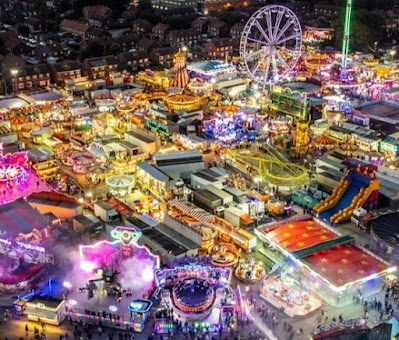The history of fun fairs, often called fairs, carnivals, or amusement fairs, is rich and varied, stretching back centuries. These events have evolved from simple gatherings into complex celebrations featuring rides, games, food, and entertainment. Here's a look at how fun fairs developed over time:
Early Origins
1. Medieval Fairs (11th - 16th Century) :
Trade and Commerce :
The earliest origins of fun fairs can be traced back to medieval Europe, where fairs were primarily commercial events. These fairs were gatherings where merchants, artisans, and farmers would come together to sell their goods and services. They were often tied to religious festivals or market days.
Entertainment Begins :
Over time, these fairs began to include entertainment such as musicians, jesters, jugglers, and acrobats. This added a festive atmosphere to what was originally a commercial gathering.
2. Religious and Agricultural Fairs :
Church Festivals :
Many early fairs were linked to religious events, such as feast days of saints or significant dates in the Christian calendar. These events included a mix of worship, trade, and entertainment.
Harvest Festivals :
In rural areas, agricultural fairs were common. These fairs celebrated the harvest and featured competitions, livestock shows, and eventually, more entertainment elements like games and rides.
The Growth of Traveling Fairs
3. 17th - 19th Century :
The Rise of Traveling Shows :
In the 17th century, the concept of traveling fairs began to take shape. Showmen, performers, and entertainers would travel from town to town, setting up temporary fairs. These events featured everything from puppet shows and freak shows to early mechanical rides.
Fairground Rides :
The first mechanical rides began to appear in the 18th century, with simple carousels being among the earliest. These rides were often powered by horses or manual labor before the advent of steam power.
Steam-Powered Rides :
The Industrial Revolution in the 19th century brought significant changes to fun fairs. The introduction of steam power allowed for more complex and thrilling rides, such as steam-powered carousels, swings, and the first Ferris wheels.
4. Victorian Ages :
Expansion of Fun Fairs :
The Victorian ages (1837-1901) saw a significant expansion of fun fairs, especially in the UK and Europe. These fairs became larger, more elaborate, and more diverse in their offerings. The Victorians loved spectacle, and fairs provided just that, with rides, sideshows, and various attractions.
Circuses and Fairs :
During this period, the distinction between circuses and fairs began to blur. Traveling circuses often set up in towns alongside fairs, adding to the variety of entertainment on offer.
The Modern Ages
5. 20th Century :
Electricity and Modern Rides :
The advent of electricity revolutionized fun fairs in the early 20th century. Electric lighting allowed fairs to operate at night, and electric motors powered new and more exciting rides like bumper cars, roller coasters, and spinning rides.
The Golden Age of Fairs :
The early to mid-20th century is often considered the golden age of fun fairs. During this time, fairs became a staple of popular entertainment in many countries, particularly in the United States and Europe. The introduction of iconic rides, such as the Tilt-A-Whirl and Ferris wheel, cemented the place of fun fairs in popular culture.
World's Fairs :
In addition to local and traveling fun fairs, the 20th century saw the rise of World's Fairs, which were grand international exhibitions showcasing technological innovation, culture, and entertainment. The 1893 Chicago World's Fair, for example, introduced the first Ferris wheel, which became an enduring symbol of fun fairs.
6. Post-War Boom :
Carnivals in America :
In the post-World War II ages, fun fairs and carnivals experienced a boom, particularly in the United States. These events became central to community life, often associated with county fairs, state fairs, and traveling carnivals.
Amusement Parks :
The rise of permanent amusement parks, such as Disneyland (opened in 1955), began to shift the focus from traveling fairs to fixed-location theme parks. However, traveling fun fairs remained popular, offering a different, more accessible type of entertainment.
Contemporary Fun Fairs
7. 21st Century :
Modern Fun Fairs :
Today, fun fairs continue to be a popular form of entertainment around the world. Modern fairs feature a mix of traditional rides, such as carousels and Ferris wheels, alongside more advanced and thrilling attractions like roller coasters, virtual reality experiences, and high-tech games.
Cultural Festivals :
Many fun fairs are now integrated with cultural festivals, food fairs, and other community events, making them a key part of local culture and heritage.
Challenges and Adaptations :
In the 21st century, fun fairs face challenges from other forms of entertainment, such as video games and theme parks, but they continue to adapt by incorporating new technologies and catering to nostalgia for traditional fair experiences.
Significance
Fun fairs have played a significant role in social and cultural life, providing entertainment, a sense of community, and a space for people of all ages to come together. Their evolution from simple medieval fairs to the vibrant and varied events we know today reflects broader changes in society, technology, and culture.
Whether through the thrill of a ride, the allure of fairground food, or the excitement of games and attractions, fun fairs remain a beloved tradition that continues to capture the imagination of people around the world.


No comments:
Post a Comment